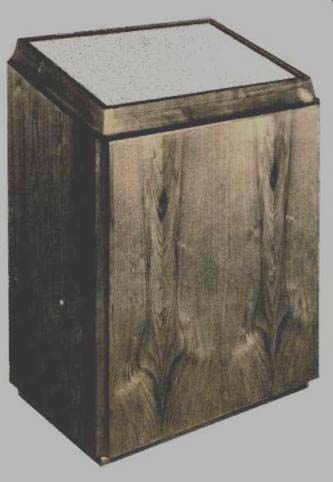
MANUFACTURER'S SPECIFICATIONS
Components: Three 7-in. woofers; one 1 1/2-in. dome midrange, and two 1-in. tweeters.
Frequency Response: 30 to 20,000 Hz.
Power Handling: 60 watts rms.
Dispersion: Essentially non-directional.
Impedance: 6 ohms.
Acoustic Loading: Dual chamber, triple vent reflex.
Weight: 75 lbs.
Dimensions: 20 3/8 in. W., 14 3/8 in. D., 29 1/2 in. H.
Price: $ 295.00.
The Citation Thirteen loudspeaker is the latest entry in the Harman-Kardon premium component line. This new loudspeaker, besides having smooth and well-balanced sound, can boast excellent dispersion thanks of an ingenious scheme for reflecting sound. The walnut finished cabinet weighs 75 lbs., which testifies to the very rigid construction of the cabinet, and must be a new high for a cabinet of this size. According to the manufacturer, the cabinet interior is constructed of high density, 1-in. particle board, using a bracing system to control panel resonance and flexing which, they note, is a common fault leading to loss of bass power and clarity. All six drivers are top mounted on a 14 degree sloping panel. This 14 degree angle brings the sound forward and establishes a firmer stereo image than is usually the case with reflecting speaker systems. The grille cloth is held in place by Velcro hooks and is user replaceable--a touch which is certain to be appreciated by the lady of the house and interior decorators as well.
The three 7-in. woofers drive a dual chamber reflex system which terminates in two unequal length tuning tubes, one for each chamber, thus stagger-tuning the system and extending as well as smoothing the low frequency response. The midrange dome radiator comes in at 2500 to 3000 Hz, overlapped by two domed 1-in. super-tweeters which enter at 7000 Hz. (See Fig. 1.) The crossover slopes are 6 dB per octave, causing minimum phase distortion and assuring smooth transition from driver to driver. (See Fig. 2.) A recess on the back of the enclosure holds a color-coded, five-way binding post, mid and high frequency balance controls, and last but not least, a speaker fuse-a feature which we would like to see adopted by more speaker manufacturers.
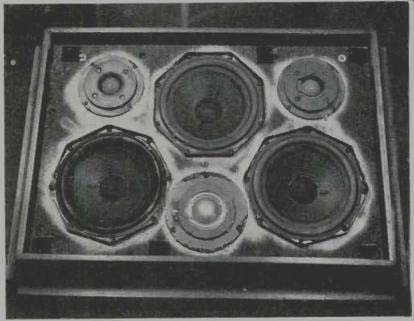
Fig. 1--Front view of the drivers, grille panel removed.
Measurements
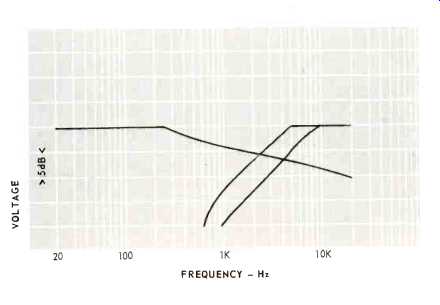
Fig. 2--Woofer, midrange, and tweeter response of the Citation Thirteen.
Note the midrange and tweeter overlap. Voltages were taken at the voice
coil of the drivers.
The average impedance is a trifle over 6 ohms (see Fig. 3), essentially as claimed by the manufacturer. At 5000 Hz and above, the impedance drops to 4 ohms. Therefore, we would not recommend using a second speaker hooked up in parallel with the Citation Thirteen on the same amplifier tap unless the amplifier can deliver power into 3 ohms or so. Distortion figures, taken at 95 dB SPL with an 8 volt input, were commendably low. (See Table I.) Since the major part of the energy is reflected, we departed from our usual on- and off-axis measurement procedure and instead took seven curves, varying the distance and height of our measuring microphone relative to the loudspeaker. The input for this consisted of 1/3 octave pink noise. At the nominal impedance 2.5 volts equals 1 watt and gave 85 dB SPL, which is somewhat more efficient than most loudspeaker systems. All response curves were taken with mid and treble controls at maximum. (Fig. 4.) From 800 to 16,000 Hz, the response was plus s 2.5 dB, which is excellent performance. Low [...] response extended to just below 30 Hz; in fact, the output at 30 Hz was remarkably high before doubling commenced. In this respect, the Citation Thirteen compared very favorably indeed with a system twice the size using a 15-in bass unit.
White noise tests confirmed the excellent dispersion and low coloration-mostly confined to the lower-mid range. The low frequency disturbances are due to room effects and will change from room to room and even within the same room depending on speaker placement. The tone burst response was very good, as evident in the photos of Fig. 5.
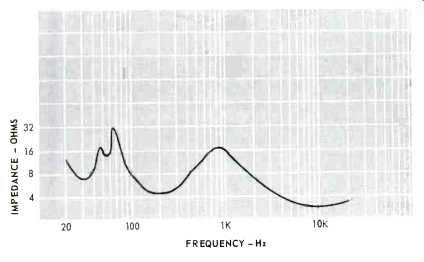
Fig. 3-Impedance curve. The peaks at 48 and 65 Hz are woofer and duct resonances.
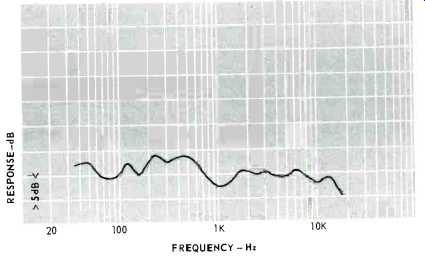
Fig. 4-Frequency response at 1/3 octave-band pink noise, averaged for seven
microphone positions.

TABLE I Second and third harmonic distortion of the Harman-Kardon Citation
13 at 10 watt input, for three test frequencies.

Fig. 5-Tone burst response at A, 100 Hz; B, 1000 Hz, and C, 10,000 Hz.
Listening Tests
During our listening evaluation, we found that depending on listening distance we preferred anywhere from 3 to 5 dB of midrange and supertweeter cut. Not surprisingly we found the speaker to have smooth, well-dispersed sound with no trace of the vagueness in the stereo image so often associated with reflecting speaker systems. Likes and dislikes in speaker design, not to mention design in general, are matters of personal taste; we found the styling of the Citation Thirteen to be clean and functional, with handsome wood grain. As mentioned above, the grille cloth can be changed at the time of purchase to harmonize with most any decor. We can summarize this report by saying that the Citation Thirteen is a very successful design and a fitting companion to the Citation Twelve amplifier (which, incidentally, was reviewed in the May, 1970, issue).
-Alex Rosner
(Audio magazine, May 1975)
Also see:
Harman/Kardon Citation 16 Basic Amplifier (Equip. Profile, Dec. 1976)
Harman/Kardon Citation Twenty-Five Preamp (Mar. 1989)
Harman-Kardon Citation Fourteen Stereo FM Tuner (Dec. 1972)
= = = =